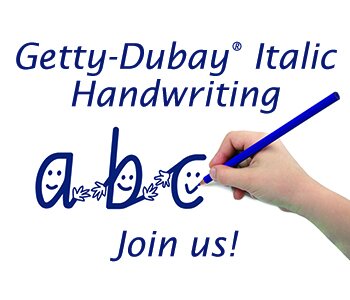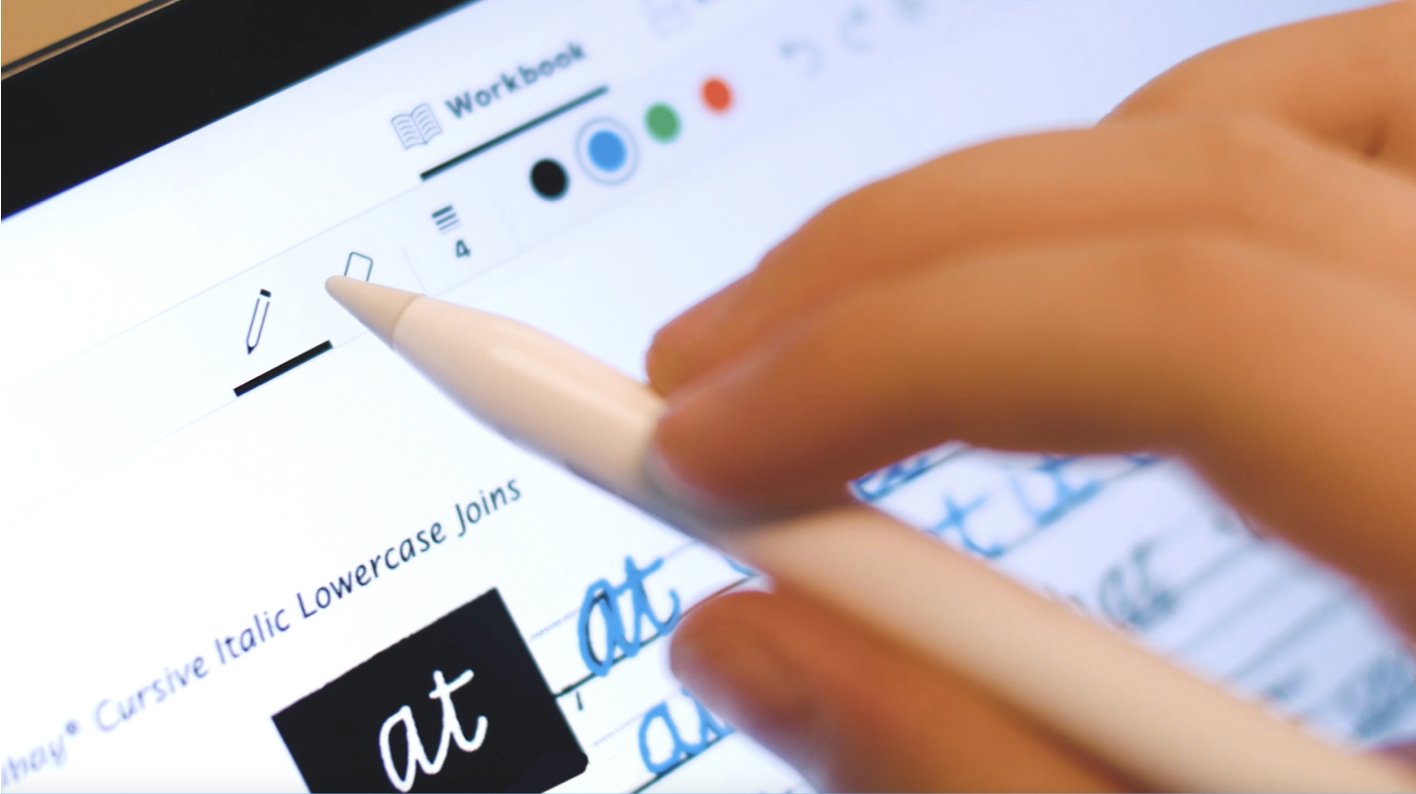Getty-Dubay® Italic Handwriting Series
Why italic? Because it’s faster than print and easier than looped cursive. And the basics are easy to master, so your everyday handwriting quickly becomes more legible and beautiful. Unlike conventional looped cursive methods, with Getty-Dubay® Italic students only learn the letters once for print, then connect them for cursive writing. This saves a ton of classroom time.
Getty-Dubay® Italic Handwriting Series: Best handwriting method for legibility
Getty-Dubay Italic is a simple, practical way to learn and improve handwriting via a unique, effective curriculum for teachers, children and even adults.
Grades: K-6th (and adults)
About Getty-Dubay® Italic Handwriting Series
Over forty years ago, the authors Barbara Getty and Inga Dubay saw a diminishing interest in handwriting instruction, due in part by the outdated and ineffective methods available at the time. As artists and teachers, they created a handwriting curriculum based on the italic style, invented over 500 years ago, that produces a legible and handsome result easily for students and adults. Looped cursive methods (Palmer, etc) require students to learn one style of writing in kindergarten then abandon it in grade 3 for an entirely different script. This requires a great deal of extra classroom time and with very low retention rates. Italic handwriting, in contrast, builds on previously learned concepts by employing the print letterforms in cursive writing. For more information, see the authors' New York Times Op-Ed here.
Handwriting is a lifelong skill that is built over time with focused attention and continual use. Direct handwriting instruction involves students copying and tracing developmentally appropriate handwriting models, with instructional scaffold that are gently removed to encourage mastery. The program is divided into seven graded workbooks and a single Instruction Manual. Ancillary material such as desk strips, wall charts, alphabet cards are also helpful. Additional worksheets and downloadable computer fonts can be used for classroom differentiation and/or alignment with other subjects.
Parents often comment on the ease of use, the legibility and beauty of the style, and that they save a ton of classroom time.
This a proven curriculum with a forty-year track record. Thousands of children learn handwriting via this curriculum every day around the world. The first three books (Books A - C) are now available in Spanish.
Handwriting Success has taken Getty-Dubay® Italic into the 21st century with new digital products such as the Handwriting Success App that presents all the Getty-Dubay® Italic handwriting books as ebooks that you can write in with a tablet and stylus. We've also created 72 downloadable Getty-Dubay® Fonts which match the models found in the workbooks. The 32 Getty-Dubay® Joined fonts join automatically as you type! We are developing more digital format resources and tools for release in the near future, and will be expanding our customer resources to help parents and teachers with advice and guidance for their direct handwriting instruction.
The science of handwriting is showing us how important handwriting is as part of building literacy and language arts skills, especially for those who have learning challenges. We hope to continually build resources and materials to meet classroom and homeschool handwriting needs for every student, aligned with evidence-based best practices.
Why you should trust Getty-Dubay® Italic Handwriting Series
This an evidence-based, proven curriculum with a forty-year track record. Thousands of children learn handwriting via this curriculum every day around the world. The Series receives consistent praise wherever it is sold and used.
Research & Development that went into Getty-Dubay® Italic Handwriting Series
The authors piloted the Italic Handwriting Series in the Beaverton (Oregon) School District before publishing via Portland State University. It quickly became the handwriting addition in the state of Oregon, as well as in other states and school districts. At the same time, homeschool parents recognized its ease and effectiveness and it has been a popular homeschool curriculum ever since.
Getty and Dubay subsequently presented 170 handwriting seminars to 4,500 doctors and other medical professionals across the United States, prompting media appearances such as on NBC's Today and ABC's Good Morning America.
Who is Getty-Dubay® Italic Handwriting Series an ideal choice for?
The Getty-Dubay® Italic Handwriting Series is for any student age K-6 and above to learn a legible and handsome handwriting that will build vital literacy and language arts skills fir lifelong use and enjoyment.
Who is Getty-Dubay® Italic Handwriting Series not a good choice for?
There are may styles of handwriting available."Cursive" is a loaded word these days, and means different things to different people. Parents who would like their children to have looped cursive writing (Palmer, Zaner-Bloser, D'Nealian, HWT) will want to choose those methods. Conversely, parents who "don't want cursive" might be hesitant to try the Series, but should understand that cursive italic may not be the style of "cursive" they dread.
The material is presented simply, without distraction, and may not be attractive to parents looking for full-color, and splashy. Similarly, the App Edition (available in the Handwriting Success App) is a series of ebooks that you can write in and does not contain gamified or interactive content. "
Flaws, but not dealbreakers
Newcomers to homeschooling often do not have the experience of learning handwriting themself (or don't remember). For this reason, we sometimes get the comment that these parents "don't know where to start." The good news is, it a very simple process -- the student can simply open the book, trace and copy, one page (or less) per day. Instruction are step-by-step and clear.
Cost
The Getty-Dubay® Italic Handwriting Series is a complete handwriting curriculum for K-6 — that's seven years of workbooks and an Instruction Manual — for $95. The Spanish Edition for K-2 with Alphabet cards is $49. Other bundles are available. Handwriting workbooks for individual grades are $13.75 each. Or, if you have a tablet and stylus, the App Edition is only $8.99 per grade. For art enrichment, the Getty-Dubay® Italic Calligraphy for School and Home workbook is $29.95 and includes optional online videos. Purchase of any workbook allows for free access to online tools and materials.
Additional tips
The authors emphasize that handwriting honors the reader, and therefore legibility is of prime importance. Students will develop their individual handwriting style -- guaranteed. Most of us don't remember what it was like to learn handwriting (or never had it taught in school), which can make the thought of teaching someone else daunting. In this case parents and teachers can model the learning process (e.g. "I don't know how to make a letter 'a' . Let's find out together"). Patience and the long view are keys.
Some parents feel that it is necessary for a student to write looped cursive in order to know how to read looped cursive handwriting by other (letters from grandma, the Declaration of Independence, etc.). It does take some instruction to decode looped cursive writing, but that skill can be learned separately from the student’s handwriting of choice (be it Italic or any other style), and fairly quickly. This is in evidence in the book Read Cursive Fast, by Kate Gladstone. The Getty-Dubay® Italic Handwriting Series Books C-G also contain supplemental sections for just this purpose
Key Features
Family Involvement
Independence: Younger grades (K-3) need supervision, older grades (4-6) much less so
Prep Time: Minimal prep time
Prerequisites
No literacy requirement As a handwriting curriculum, reading is a component of the skills being built.
Must have physical use of a writing hand.
Suggested time commitment
Varies depending on the grade level (20 minutes per day of K to 40 minutes twice a week for 6th grade).
Learning Approach
Type of tool: App, Website, Textbook, Workbook (consumable) and other physical ancillary materialsAdaptive: No, it is the same for every student
Modality: Visual, Hands-on/kinesthetic (choose this if kids use gross motor skills and touch different textures, e.g. building something with their hands, not just typing on a screen)
Philosophy: Not influenced by a particular educational philosophy
Other: Hands-on, Project-based, Self-directed learning, Mastery-based, A scaffold for reading and writing
Cognitive Diversity*
Neurotypical
ADHD
Aspergers
Autism
Gifted
Dyslexia
Dysgraphia
Profoundly Gifted
Handwriting is considered an intervention for Dyslexia, Dysgraphia and OWL LD.
*The tool may have not been designed with these special needs in mind, but have been used successfully with this learning categories.
Technology
Screens: Screens are optional. There are workbooks and a digital app. Parents may use online supplemental tools and materials that they print.
Online or Offline: All student material can be used offline
Devices: IoS, Android
Accountability
State Standards: Yes, it is aligned with state and federal standards
Common Core: Aligned with Common Core
Assessment: Self-assessment tools built in, Assessment tools in teacher Instruction Manual
Teacher/Parent Accounts: No, there are no teacher accounts
Common Concerns
Weapons: No, there are no references to weapons
Competitive: No, it is not competitive
Online connections: No, kids can not connect with other users online
Languages this resource is offered in
English
Spanish





The Village Electric is a CoLearning Center in Mountainside, NJ for PreK-6th grade students. Independent teachers can also book the space for classes and private lessons.